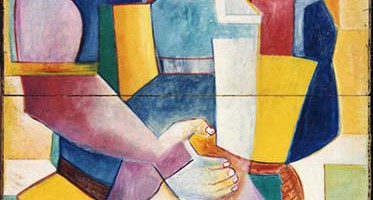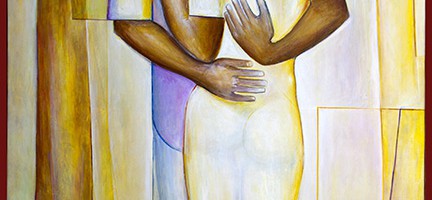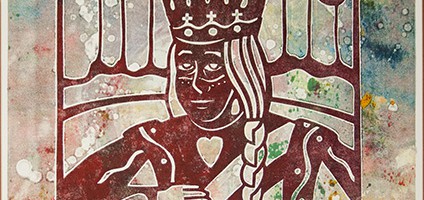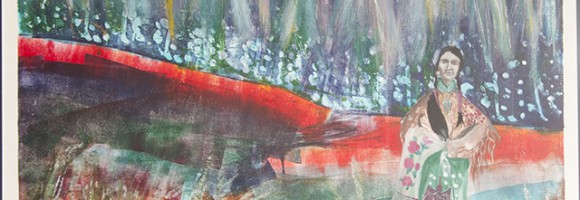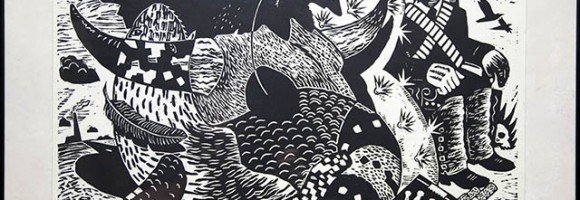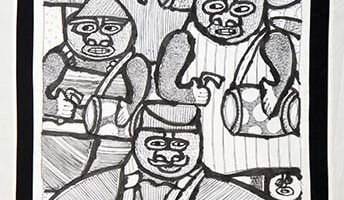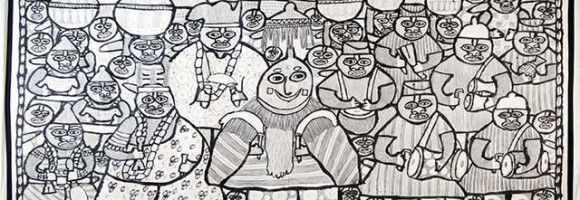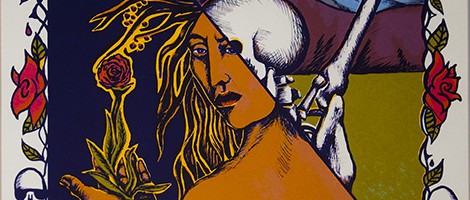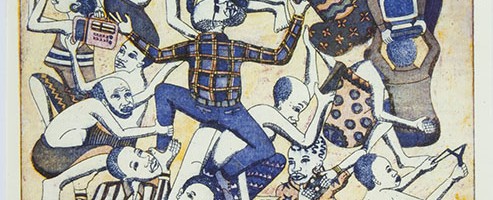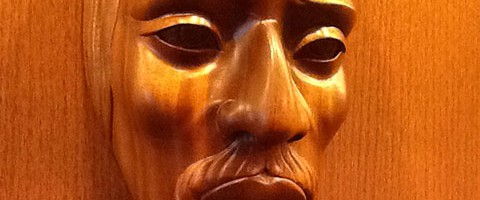Francis X. Nnaggenda
These paintings by Francis Nnaggenda are very significant to the arts program at Promega Corporation. The largest painting belonged to the original collection of about 60 paintings I brought from Kenya in 1995. The showing of these paintings, in addition to the large wooden sculpture of mother and child in the Promega BTC atrium, comprised the first exhibition I curated at the BTC.
The painting on canvas was created in response to the larger of the two. Many years ago, I bought and hand-delivered a roll of fine canvas, paints and brushes to Nnaggenda in Uganda. I wanted to assure this painting could be created with the best materials, as they are hard to find in Africa. My hope is to sell this painting and send money back to Nnaggenda. The third, smaller, painting was a gift from the artist. Although this painting is very small it has “size.”
The mother and child wood carving located in the BTC Atrium originated from a tree culled from the woods near the North Promega Building in 1995. That year, we cut down a black walnut tree, placed it in my Ford F150 and drove it to Nnaggenda at Indiana University at South Bend (IUSB). He carved it there during his artist in residence, which I arranged. It took five weeks to complete and was on display at the IUSB Gallery for one day, after which it was returned here, where it has been on display since.
Francis X. Nnaggenda
These paintings by Francis Nnaggenda are very significant to the arts program at Promega Corporation. The largest painting belonged to the original collection of about 60 paintings I brought from Kenya in 1995. The showing of these paintings, in addition to the large wooden sculpture of mother and child in the Promega BTC atrium, comprised the first exhibition I curated at the BTC.
The painting on canvas was created in response to the larger of the two. Many years ago, I bought and hand-delivered a roll of fine canvas, paints and brushes to Nnaggenda in Uganda. I wanted to assure this painting could be created with the best materials, as they are hard to find in Africa. My hope is to sell this painting and send money back to Nnaggenda. The third, smaller, painting was a gift from the artist. Although this painting is very small it has “size.”
The mother and child wood carving located in the BTC Atrium originated from a tree culled from the woods near the North Promega Building in 1995. That year, we cut down a black walnut tree, placed it in my Ford F150 and drove it to Nnaggenda at Indiana University at South Bend (IUSB). He carved it there during his artist in residence, which I arranged. It took five weeks to complete and was on display at the IUSB Gallery for one day, after which it was returned here, where it has been on display since.
Randy Kemp
These prints are by a group of artists I have become close with since moving to Arizona in 2001, most of which have exhibited work at Promega. All of these artists belong to several organizations comprised of Latino and American Indian artists in the Phoenix area.
I’ve come to find a very rich art scene in Arizona, much as I did living in Kenya years ago. In both places, I became involved with and had the good fortune to work with artists and to exhibit their work.
I have encountered great artists all over the world and have somehow managed to end up with a diverse collection of art pieces to remind me of those relationships. By far, the most interesting and valuable aspect of what I do is getting to know unique and fascinating people.
Damian Charette
These prints are by a group of artists I have become close with since moving to Arizona in 2001, most of which have exhibited work at Promega. All of these artists belong to several organizations comprised of Latino and American Indian artists in the Phoenix area.
I’ve come to find a very rich art scene in Arizona, much as I did living in Kenya years ago. In both places, I became involved with and had the good fortune to work with artists and to exhibit their work.
I have encountered great artists all over the world and have somehow managed to end up with a diverse collection of art pieces to remind me of those relationships. By far, the most interesting and valuable aspect of what I do is getting to know unique and fascinating people.
Ke’t Lars’n
I acquired this print at an estate sale about two years ago. Although I have little information regarding this piece, I clearly see the quality of the wood-cut block print and venture to guess it depicts the story of a past conflict in the area of Douglas and Agua Prieta.
Despite being recently formalized as sisterhood cities, the border town of Douglas, Arizona and the adjoining city of Agua Prieta, Sonora in Mexico have historically been hosts to a variety of conflicts.
Michael Ayodele
These two drawings are by a Nigerian artist named Michael Ayodele. I acquired these at an auction at the University of Wisconsin-Madison.
The narrative of these graphics is quite extraordinary. Like many African artists, Michael tells contemporary stories with a traditional slant. Although I was unable to find much information regarding the artist and his background, I have seen other Nigerian artists doing similar work. An artist by the name of Twins Seven Seven would be the most famous of this group.
Find out more about Modern African Art.
Michael Ayodele
These two drawings are by a Nigerian artist named Michael Ayodele. I acquired these at an auction at the University of Wisconsin-Madison.
The narrative of these graphics is quite extraordinary. Like many African artists, Michael tells contemporary stories with a traditional slant. Although I was unable to find much information regarding the artist and his background, I have seen other Nigerian artists doing similar work. An artist by the name of Twins Seven Seven would be the most famous of this group.
Find out more about Modern African Art.
Martin Moreno
These prints are by a group of artists I have become close with since moving to Arizona in 2001, most of which have exhibited work at Promega. All of these artists belong to several organizations comprised of Latino and American Indian artists in the Phoenix area.
I’ve come to find a very rich art scene in Arizona, much as I did living in Kenya years ago. In both places, I became involved with and had the good fortune to work with artists and to exhibit their work.
I have encountered great artists all over the world and have somehow managed to end up with a diverse collection of art pieces to remind me of those relationships. By far, the most interesting and valuable aspect of what I do is getting to know unique and fascinating people.
Robino Ntila
Robino Ntila is an artist based in Tanzania. He works with artists all over Africa, conducting printmaking workshops, mostly with the support of the Ford Foundation. He has taught many artists how to print, helping them market their work in the process.
Robino worked closely with the famous Makonde artist George Lilanga, teaching him the art of printing. Lilanga, one of the few early carvers able to transition from three-dimensional to two-dimensional work, made the transition from carver to visual artist in a movement called Tinga Tinga. His distinct style characterized the start of the movement in Tanzania, one which Ntila continues today, alongside Lilanga’s son.
I met Robino Ntila in Nairobi in 1994. I have more than one hundred Ntila prints, as the artist used to send them to me once a year. Today, Ntila has taken to painting, and thus no longer sends me etchings.
Zarco Guerrero
In the fall of 2008, Promega displayed a number of Zarco Guerrero’s masks alongside the photography of his uncle, Pedro E. Guerrero. I got to know Zarco just after moving to Arizona in 2001. When I realized Zarco and my friend, Pedro, were related, I proposed creating an exhibition involving the talented Guerrero family.
Zarco Guerrero is a multi-talented artist, best known for his masks. You can see the Japanese influence in his method of carving, as he studied there. Most of his masks are made for live performances and meant to be worn. Zarco supplies masks and costumes for performances all over the world.
